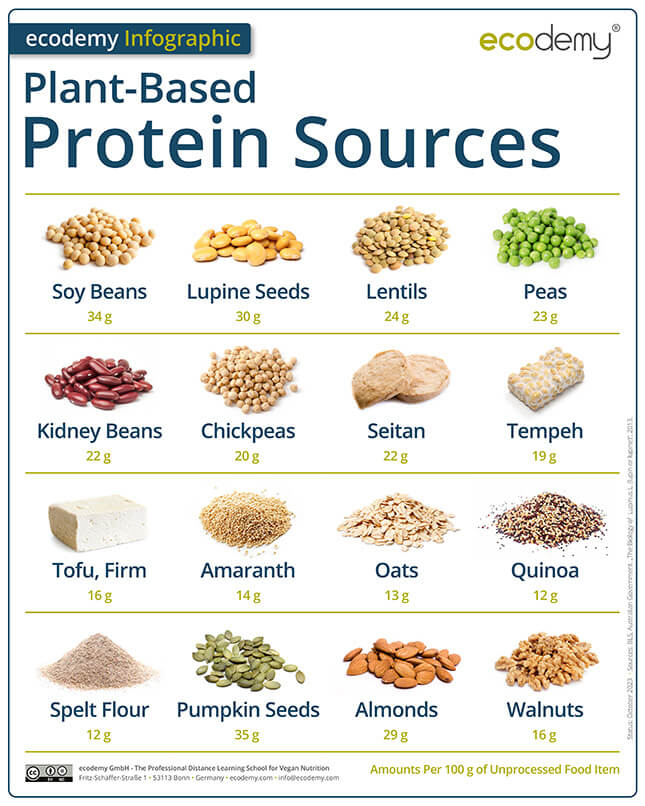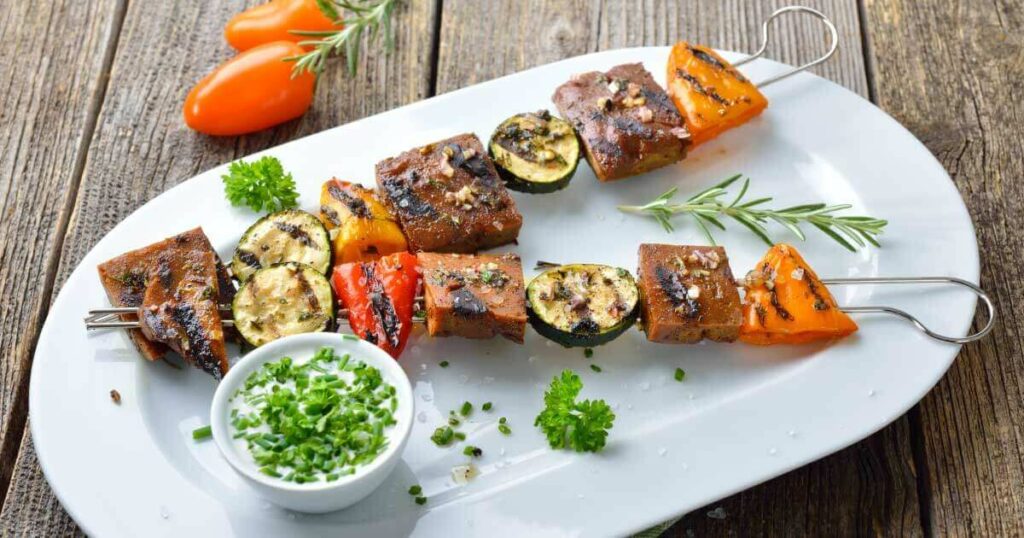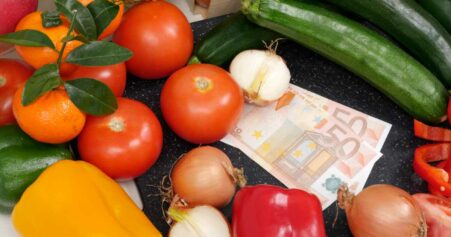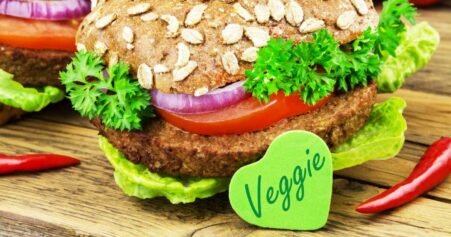Table of Contents
Seitan: Hardly any plant-based meat substitute is as versatile or comes as close to the texture of meat. But as is almost always the case, it’s the way it is prepared that determines whether it’s a flavor flop or top. This article will tell you what seitan is, what you can do with it, and who should not have it.
Did you know …
… that seitan can be translated as “made of protein” (Shurtleff and Aoyagi, 2010)?
Production
Seitan was first developed by Kiyoshi Mokutani in Japan in 1961, and commercial production began there in 1962 (Shurtleff and Aoyagi, 2010). The basis of seitan is the wheat protein gluten. This makes it particularly popular with people with soy allergies who cannot have tofu and the like. Gluten is extracted from wheat flour by kneading it in water to wash out the starch. The remaining wheat protein is then cooked with spices and other ingredients and, if desired, processed into seitan products. Depending on the type of product, you can find it in stores either refrigerated or non-refrigerated in jars or in the form of alternative products.
Making Seitan Yourself
What machines do on a large scale in industry, you can do at home. The process is a bit tedious, but actually quite simple:
- Knead 1 kg of white wheat flour well with 600 ml of water for about 10 minutes until an elastic dough is formed.
- Place the dough in lukewarm water and refrigerate for about an hour.
- Then knead it carefully under water to wash out the starch. The dough will probably disintegrate, but that’s not a bad thing.
- When the water is cloudy, pour it through a fine sieve to catch the dough pieces and replace the water. (You can use the drained water as a base for cereal milk.)
- Continue kneading and draining until the water is mostly clear.
- If desired, add spices or soy sauce and divide the remaining gluten directly into portions.
- Boil the portions in a pot of strong vegetable stock and simmer for 20 minutes to an hour, depending on size.
- Watch the gluten pieces grow in size as they cook.
If all this sounds too complicated, you can also use ready-made wheat gluten flour, which you can buy at health food stores, well-stocked supermarkets, or online. If you use it, you do not have to wash the gluten out of the wheat flour first. Just knead the flour with water and cook it in vegetable broth.
Whether you knead it yourself or just mix it together, the result is the seitan base. You can store it in the broth in the refrigerator for a few days, or freeze it (without the broth).
You can then use the seitan to make a variety of delicious dishes to your liking. See below for suggestions.
Nutrition Facts and Taste
Seitan has a neutral flavor and a slightly chewy, meaty consistency. Table 1 shows the average nutritional values of seitan per 100 grams. Nutrient content may vary depending on preparation method and manufacturer.
Table 1: Average nutrient content of seitan per 100 g (USDA, 2019).
| Energy | 118 kcal |
| Protein | 22.3 g |
| Carbohydrates | 5.3 g |
| Fiber | 1.3 g |
| Fat | 1.3 g |
| Iron | 10.7 mg |
Being almost pure wheat protein, seitan contains very little carbohydrates and fat. Therefore, in a vegan diet, its high protein content is of particular relevance. However, it provides relatively little of the essential amino acid lysine, which is the limiting amino acid. Therefore, its protein quality is low. It is therefore beneficial to combine seitan with legumes, which are rich in lysine but poor in methionine. The latter is sufficiently present in wheat and thus in seitan, making seitan and legumes a strong team.

Seitan is low in fiber and micronutrients. However, since it is not usually eaten on its own, you can increase the nutrient density of the meal by combining it with other foods.
But be careful: Since seitan is usually processed and sold as a meat alternative, a number of other ingredients are added and it is fried or deep-fried. This changes the nutritional profile of the product. A look at the ingredient list and the nutrition facts label will tell you how the product contributes to your nutrient intake.
Gluten
What exactly is this ominous “gluten” that has such a peculiar consistency? In wheat, gluten is made up of the protein fractions gliadins and glutelins (Andersen et al., 2015).
It ensures that baked goods hold together and retain their shape (like a glue). If you have ever tried to make bread with pure buckwheat flour, you know that you cannot just replace gluten-containing flour 1:1 with gluten-free flour. The bread will fall apart.
Those with gluten intolerance have to avoid the protein and therefore cannot tolerate seitan. In addition to celiac disease and gluten sensitivity, this also includes wheat allergy. In this case, the immune system reacts to the wheat protein by forming antibodies and allergic reactions can occur (Biesalski et al., 2018).
How to Use Seitan
Industrial Processing
The industry takes advantage of the meat-like and spongy consistency of seitan. This allows for easy absorption of seasonings, marinades and sauces, and a wide variety of processing options.
Added ingredients include:
- spices and herbs
- vegetables
- fats and oils
- thickeners, such as guar gum and starches
- flours
- algae (for fishy flavor)
- flavorings
- other additives, vitamins, etc.
The products are sometimes smoked to give them a more spicy, meat-like flavor.
In meat and fish alternatives, seitan forms the basis for the substitution of
- steaks
- burgers
- gyros
- roasted goose
- sausages and cold cuts
- fish and fish products.
You can use the finished products, for example, as fillings for skewers for wraps, as toppings for pizza and bread, in hot dogs, or in casseroles. Keep in mind that the processed products are often high in calories and fat, and incorporate them into your diet accordingly.
Ideas for Using Seitan at Home
If you do not use the pre-made products, but instead use either a homemade or store-bought seitan base, you can get creative. Depending on the marinade, sauce, or spices you choose, as well as the method of preparation, you can create a wide variety of flavors. Particularly recommended: the use of cumin, garlic, paprika, onions, soy sauce, mustard, tomato paste or yeast flakes. But of course you can use whatever you like and combine everything. You can then prepare the seitan by breading it, frying it, grilling it, or processing it into goulash, bolognese, and the like.
Conclusion
For those who enjoy the taste and texture of meat, seitan is a great way to reduce your consumption of products of animal origin. The special properties of wheat protein can make it easier for (former) meat lovers to switch to a plant-based diet. In addition, with its high protein content, seitan can bring benefits to a plant-based diet.
Making your own seitan or processing the base allows you to be creative and experiment with different seasonings and marinades. It’s fascinating to see the products the industry makes from seitan. You may even be able to win over the odd meat lover at family gatherings.









Leave a Reply